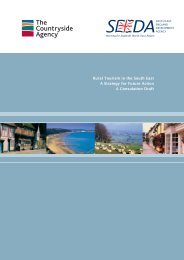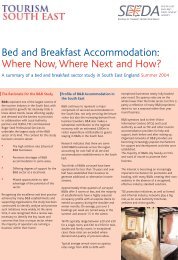Areas of Outstanding Natural Beauty - Publications and products
Areas of Outstanding Natural Beauty - Publications and products
Areas of Outstanding Natural Beauty - Publications and products
You also want an ePaper? Increase the reach of your titles
YUMPU automatically turns print PDFs into web optimized ePapers that Google loves.
A guide for AONB partnership members<br />
National Parks <strong>and</strong> AONBs<br />
National Parks <strong>and</strong> AONBs have their origins in the same movements to protect the countryside <strong>and</strong> were both designated under the<br />
National Parks <strong>and</strong> Access to the Countryside Act 1949. Both have equal importance in l<strong>and</strong>scape quality terms; both are designated to<br />
conserve <strong>and</strong> enhance natural beauty. Both have the same level <strong>of</strong> protection in planning policy. Also, like National Parks, public bodies<br />
etc. must contribute to AONB management by having regard for AONB purposes. However, there is a distinct differences in the purposes<br />
<strong>and</strong> reasons for designation in relation to recreation. National Parks have an additional purpose to promote opportunities for people to<br />
underst<strong>and</strong> <strong>and</strong> enjoy their special qualities.<br />
Management is also different, National Parks have their own National Park Authorities, which are local authorities in their own right<br />
<strong>and</strong> have their own planning, development control functions <strong>and</strong> other executive powers. They receive funds directly from central<br />
government <strong>and</strong> can precept funds from local authorities. AONBs are largely managed as part <strong>of</strong> their general duties by local authorities:<br />
or in some cases conservation boards.<br />
What about planning <strong>and</strong> development control?<br />
The town <strong>and</strong> country planning system has a major role in influencing<br />
l<strong>and</strong>scape character <strong>and</strong> diversity. It plans for the use <strong>of</strong> l<strong>and</strong> <strong>and</strong><br />
controls where certain types <strong>of</strong> development should take place.<br />
Planning authorities (county, district <strong>and</strong> unitary councils) must<br />
include policies in development plans that favour the conservation <strong>of</strong><br />
the natural beauty <strong>and</strong> character <strong>of</strong> AONBs. Their development control<br />
decisions should follow these policies <strong>and</strong> provide AONBs with a<br />
framework that integrates social, environmental <strong>and</strong> economic factors<br />
to allow for the conservation <strong>and</strong> enhancement <strong>of</strong> the AONB in the<br />
longer term.<br />
Planning<br />
The Countryside Agency’s policy on planning in the countryside 4 includes the vision:<br />
We want to pass on to future generations the sort <strong>of</strong> development which will help make<br />
their livelihoods <strong>and</strong> l<strong>and</strong>scapes as good as we enjoy; <strong>and</strong> we want to pass it on with pride.<br />
We also seek a countryside which is rich in natural beauty, biodiversity <strong>and</strong> character.<br />
4. Planning tomorrow’s countryside, 2000, CA 60,<br />
The Countryside Agency.<br />
AONB designation is not about stopping development, but it<br />
encourages development to be approached with special care. Poorly<br />
designed, or located development can spoil the character <strong>of</strong> an area,<br />
but some development can have great social <strong>and</strong> economic benefits for<br />
the community which can further AONB aims in the long term.<br />
10
















